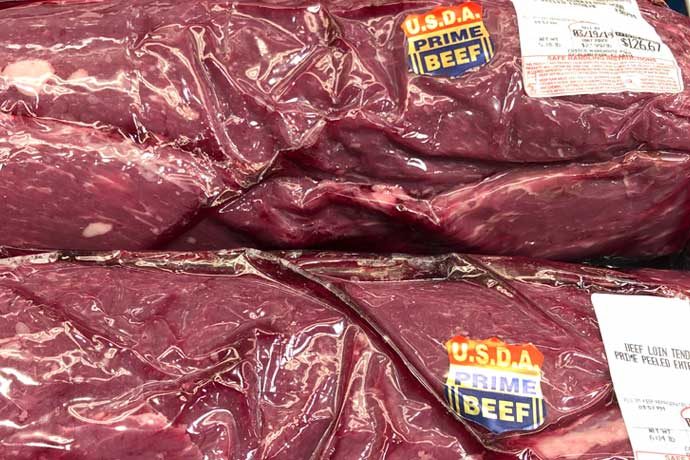There may be pandemic fatigue, given the dizzying pace of the past year, but the truth is that almost every aspect of the food supply has been affected by the global health crisis – even the production and packaging of whole-muscle meats.
For one thing, the significant and rapid switch from foodservice to retail buying had implications in both channels.
“The recent events in the world are impacting whole muscle demand in some unique ways. The temporary downturns in the foodservice sector have opened a multitude of opportunities on the retail side, both conventionally and in new ways,” said Mike McCann, packaging specialist for Reiser, Canton, Mass. “Many processors who earlier in the year were supplying foodservice businesses with whole-muscle products have had to quickly switch gears and instead supply smaller retail packs.”
Moreover, what shoppers are buying at retail is different than it was in January or February. “Consumers are shopping hard, both in person and via online service, in some cases initially even hoarding protein. Our customers have reacted to supply more retail-sized portions, club-style packs, larger piece count packs, as one direction,” he said.
Consumers who are stocking up for a long winter with possible supply chain disruptions and stay-at-home restrictions may also find whole-muscle products appealing for practical reasons. “Whole-muscle meats are essentially sterile inside. With the exception of fresh fish, which has different safety requirements, removing the oxygen from the outside of the muscle dramatically extends the shelf life of the product,” said Christian Uebele, product market manager, thermoforming, for Multivac Inc., Kansas City, Mo.
At the same time, there is growing demand for ready-to-assemble meals that include a pre-packaged protein. “Others have pursued more singular portion offerings, even supplying the wide spectrum of meal kit companies with a full range of individually packed proteins for their meal offerings,” McCann said.
Meanwhile, although their dining rooms may be shuttered, some restaurants have pivoted to offering meal components to go, including whole-muscle cuts of meat or poultry. That includes large pre-packaged portions for holiday gatherings, like large beef tenderloins, hams or whole birds.
Sealing the deal

If the market for whole-muscle cuts is shifting – and may shift again depending on what 2021 brings – there are a host of packaging options designed for a range of needs, from packaging with bone guards for bone-in items to packaging designed to stand out at the point of sale.
Uebele said packaging for whole-muscle products with a longer shelf life can be created for optimal safety, integrity and eye-appeal.
“From the simplicity of a lower formed VSP package to the higher visual impact of a MultiFresh or FormShrink package, the main goal is preserving the food and extending the distribution chain,” he said, noting that thermoform packaging machines offer a variety of packaging forms to protect and display products.
Those options include a formed lower web vacuum package or a formed lower web vacuum skin pack package that seem to be the most common for whole-muscle cuts, according to Uebele. Multivac also offers another level of packaging that reverses the protrusion by keeping the lower web flat and allowing the upper film to conform to the product, and has a technology called MultiFresh for products positioned below and above the webline. Its FormShrink solution is used when the upper and lower web conform around the product.
At Reiser, McCann said that a diverse lineup of packaging solutions helps meet shifting marketplace demands and trends. Among other solutions, Reiser offers premade vacuum bag systems, horizontal form/fill/seal packaging machine lines, preformed tray sealing machinery, and shrink/overwrap packaging. Its Supervac vacuum chamber packaging machines are used for whole-muscle packaging, using premade bags and a double Biactive sealing system to eliminate leakers.
“All of these product lines are supplied with the same standards: keep it simple, easily accessible for changeovers and maintenance trouble shooting, and designed with maximum versatility for circumstances like what has occurred this year,” he explained.
In addition to packaging equipment, materials for whole-muscle cuts are also designed to keep pace with the needs of retailers and foodservice operators and, ultimately, with consumer expectations. For example, film clarity is one important element, so consumers have literal transparency to make decisions. And at a time when sustainability is a top-of-mind driver, expect more materials that are part of the circular economy or earth-friendlier in some other way.
Like retailers and restaurants, packaging providers have likewise found themselves adapting over the past year.
“Our processing product lines have the same mandate and have been quickly reconfigured from foodservice needs to retail styles wherever applicable,” McCann said. “We have been fortunate to be able to help numerous customers react on the fly as this year has demanded and in partnership with our suppliers, are keeping that supply chain moving for our customers and their customers,” he added.




